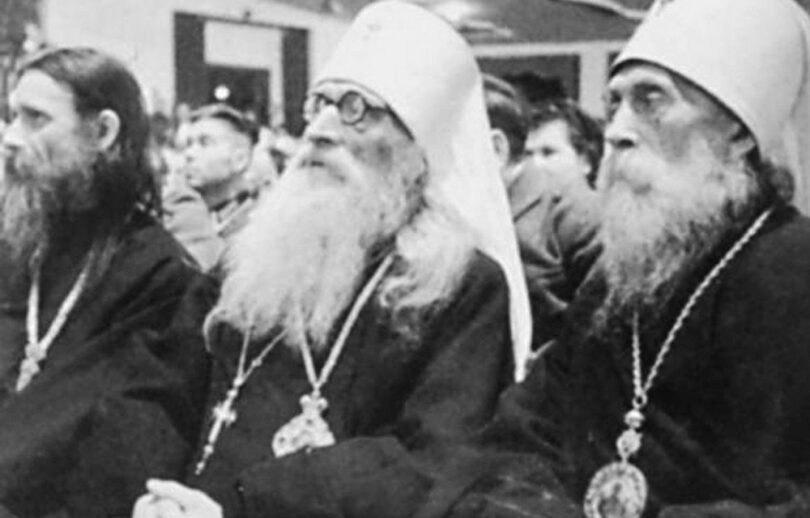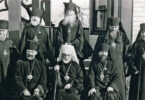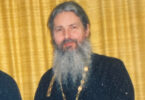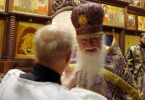On this day in 1939, Metropolitan Seraphim (Lade) made an agreement with Bishop Sergei (Korolev) of Prague regarding the submission of his parishes to the ROCOR.
Metropolitan Seraphim’s life resembles St. Anthony the Roman, who came to Novgorod from the West in the twelfth century. Here is what the historian of the Russian Church Abroad Dr. Gernot Seide (Fr. George), writes about him:
“Born into a Protestant family in Leipzig, where he received his secondary education. 1903, he converted to Orthodoxy in the Russian Orthodox Church in Dresden. 1905-07 studied at the St. Petersburg Theological Seminary. 1907, married and was ordained to the diaconate. Served in Novgorod and Volyn’. 1912, he was ordained to the priesthood and entered the Moscow Theological Academy, from which he received the degree of Candidate. 1916-19 taught at the Kharkiv Seminary. In 1920, he was widowed and in 1924, tonsured a monk. In the same year, he was elevated to hegumen and archimandrite and became abbot of the Holy Protection Monastery in Kharkov” (History of the Russian Orthodox Church Outside Russia from Its Beginning to the Present. Part VI. Comprehensive Index of the Bishops of the Church Abroad with Short Biographies. Historical Studies of the Russian Church Abroad.)
In 1924, then-Archimandrite Seraphim received his episcopal consecration from the Synod of Metropolitan Pimen (Pegov), who was a part of Renovationist (schismatic) movement in Ukraine. Since the future Metropolitan Seraphim spent many years collecting historical evidence about the Lord, he was appointed Chairman of the Committee on Education and the Committee for Combatting Unbelief. In 1930, along with many other Russians of German descent, he was allowed to leave the USSR for Germany. In August of 1930, the ROCOR Synod decided to receive him without his being (re)ordained (through repentance). This fact of the reception via repentance later caused Bishop Leonty of Berdichev (later of Chile and Peru) to refuse to recognize as valid ordinations performed by Metropolitan Seraphim.
Metropolitan Seraphim became a timely replacement for Bishop Tikhon (Liashchenko). In 1936, the German Diocese of the ROCOR received the rights of a public corporation and in 1938, with subsidies from the Third Reich government, a new cathedral was built in Berlin. Since the Nazi regime officially recognized only one Orthodox Church – the ROCOR – the parishes of Metropolitan Evlogii (the Russian jurisdiction under Constantinople) were forced to join the Russian Church Abroad. Among those clergy who came over to the ROCOR and never left was Fr. Manuel Essensky, the rector of the Leipzig parish (later a bishop in the ROCOR)
Although Metropolitan Seraphim (Lade) would defend the regime of the Third Reich on the international scene, similarly to the defense of the Soviet regime by the Moscow Patriarchate bishops, he made exceptions to the submission of Metropolitan Evlogy’s parishes to the ROCOR. For instance, after the German occupation of the Czech lands, he agreed that Metroplitan Evlogii’s vicar bishop Sergii (Korolev) of Prague would remain in subordination to Metropolitan Evlogii while being in Eucharistic communion with Metropolitan Seraphim. From the point of view of the state, he became responsible for them, because the state had given the ROCOR rights of corporation.
Overall, I believe, Metropolitan Seraphim’s nomination as the head of the diocese helped the ROCOR enormously during these difficult times. Dr. Seide writes in the cited above source about his contribution for introducing Orthodoxy in Germany:
“Thanks to his theological and religious education and also to his German ancestry, he made Orthodoxy known widely among the German population and conducted a regular dialogue with other confessions. (…) As a theologian, he published many writings, which spread the understanding of Orthodoxy in the German-speaking world, including Science and Religion (Wissenschaft und Religion, 1946); The Immortality of the Soul (Die Unsterblichkeit der Seele, 1947); Apologetical Essays (Apologetische Aufsätze, 1948); Orthodox Dogma (Das Orthodoxe Dogma,1948); The Eastern Church (Die Ostkirche, 1950).”
In 1942, he received the title of Metropolitan Seraphim of Central Europe, referring to his parishes in Austria, the Czech lands and Slovakia. This title somehow reflected the idea of Metropolitan districts adopted at the Bishops’ conference in Sremski Karlovci in 1935. He died in Munich with the same title in 1950.
Sources:
Dr. Gernot (Fr. George) Seide, “History of the Russian Orthodox Church Outside Russia from Its Beginning to the Present. Part VI. Comprehensive Index of the Bishops of the Church Abroad with Short Biographies.” Historical Studies of the Russian Church Abroad.
Monk Benjamin (Gomarteli), “Letopis’ tserkovnykh sobytii nachinaia s 1917 goda.” Part III. 1939-1949. [Timeline of the church events beginning from 1917.] Historical Studies of the Russian Church Abroad.











